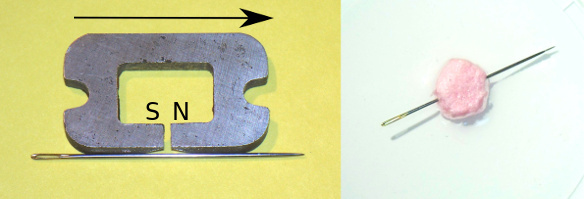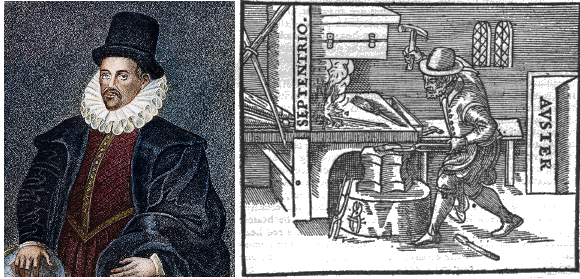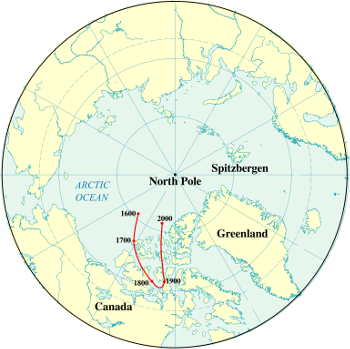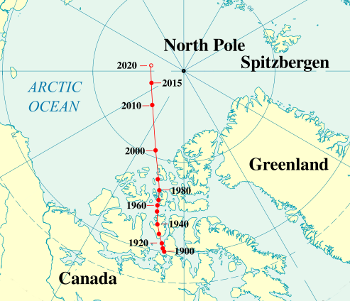Magnetic North
February 11, 2019
One of my first
childhood experiments was the creation of a
sewing needle compass. I
magnetized a sewing needle by
stroking it against a
magnet, then I poked it through a
cork and
floated the cork and needle in a
bowl of
water. The needle
turned to orient itself with the
Earth's magnetic field.
Ancient mariners used this same simple compass, although the
convention at that time was to have the needle point
south instead of
north. Eventually, such needles were suspended in
air by thin
strands of
silk and not floated on water.[1]

Making a sewing needle compass. The sewing needle is magnetized by stroking it unidirectionally against a magnet, this action causing some of ferrous polycrystals in the needle to align their magnetic moment in the same direction. One other method of magnetization is to pass an electrical current through the needle. This can be done by a momentary connection to a battery's terminals, but you shouldn't do this with a lithium battery. Short-circuited lithium batteries sometimes ignite. While corks are not common today, Styrofoam packing peanuts are common, and they serve the same purpose. (Photos by the author.)
The only magnets known to the ancients were the
natural magnets called
lodestones. Lodestones are magnetized specimens of the
mineral,
magnetite (Fe
3O
4). The
sixth century B.C. Greek philosopher,
Thales of Miletus (c.624 - c.546 BC), wrote about the attraction of lodestones to themselves and to
iron. The reason for the direction seeking property of the compass, the magnetic field of the Earth, was not known to the ancients, but there are numerous examples throughout
history of things being used without an understanding of how they work.
Conjecture in those times was that there was a magnetic
island situated in the far north; or, that
Polaris, the Pole Star, was magnetic.
The
Earth's magnetic field is comparatively feeble, just 0.25 to 0.65
gauss at its surface. In comparison, a
barium ferrite (BaFe
12O
19)
refrigerator magnet has a field strength of up to several thousand gauss. However, we're fortunate that the Earth's magnetic field is sufficiently large to direct
cosmic rays away from Earth's surface. Cosmic rays are directed to the
poles, since the Earth's magnetic field lines run
longitudinally. That's why
auroral displays occur at the poles.
Evidence that the Earth was a giant magnet was first presented in 1600 by the
English physician,
William Gilbert (1544-1603). That's when Gilbert
published the first modern study of magnetism,
De Magnete.[2] To demonstrate that the
Earth was a giant magnet, Gilbert created a
sphere of lodestone, which he called a
terrella. He showed that this
model of a magnetic Earth caused the same deflection of a compass needle at its
surface as a compass on the Earth.

William Gilbert (1544-1603) with a woodcut from his De Magnete. The gilbert, a unit of magnetomotive force, was named in honor of Gilbert. The woodcut illustrates how hot iron can be magnetized by being worked on an anvil with its axis aligned north-south. The Latin word for North is septentrio, and the Latin word for South is avster/auster). (Gilbert portrait by Charles Henry Granger (1812-1893), via Wikimedia Commons. De Magnete Illustration no. 125, via Wikimedia Commons.)
So, how is Earth's magnetic field created, and how stable is it? The Earth's magnetic field is apparently generated by a
dynamo action of
liquid iron in its
core. For this reason, it's subject to the peculiarities of
hydrodynamics, including spontaneous reversals of the
fluid flow. When this happens, there's a
spontaneous reversal of the
magnetic polarity with the north-south direction being reversed and compass needles pointing the other way. These
geomagnetic reversals have happened often in
Earth's history (see figure).

Geological record of magnetic reversals. The blue periods are those with our present magnetic polarity having compass needles pointing north. Short-term field flips, such as the 440 year Laschamp reversal event, 41,000 years ago, occur within the extended periods shown. (Data from U.S. Geological Survey Open-File Report 03-187, via Wikimedia Commons, modified for clarity.)
Do bad things happen during such field reversals? Are there consequences to
life through an excess of cosmic rays reaching the surface of our
planet during these events?
Scientists have found no
extinction events during geomagnetic reversals, and they have determined that the Earth's magnetic field decreased by just 5% during the short (440
year)
Laschamp reversal event that occurred 41,400 ± 2,000 years ago.[3]
The
North Magnetic Pole is located quite distant from the
rotation pole of the Earth. In 2001, it was near
Ellesmere Island in northern
Canada at
81.3°N 110.8°W, but it wanders quite a bit from year to year, as shown in the figure. It's been found recently that the rate of polar shift has increased.

Movement of the magnetic north pole, 1600-2000.
(Base map by Jamiri, via Wikimedia Commons, data from ref.4.[4] Click for larger image.)
James Clark Ross, of the eponymous
Ross sea and
Ross Ice Shelf in
Antarctica, first measured the motion of the
magnetic north pole in 1831.[5] Its location seems to be a controlled by large magnetic sources beneath Canada and
Siberia, and its current motion implies that the pull towards Siberia has become stronger.[5] Its present rapid motion might be linked to a high-speed
jet of liquid iron beneath Canada.[5]
While the north magnetic pole didn't move much during most of the
20th century, it's made up for lost time in the last 40 years.[6] At this point it's moving at about 30
miles (50
kilometers) per year, and it crossed the
International Date Line into the
Eastern Hemisphere in 2018.[5-6]
As can be expected, an accurate compass direction throughout the globe is predicted by a
mathematical model, called the
World Magnetic Model, the most recent revision of which was on Dec 15, 2014.[5] Every model has its limitations, and a geomagnetic
pulse beneath
South America in 2016 caused large
errors just after the update to the model.[5] Although the next model update isn't scheduled until December 31, 2019, the errors are nearly at the acceptable limit for
navigation, so an interim update is planned.[5]

North magnetic pole location from 1900-2015, with an extrapolation to 2020.
The pole is now moving at about 30 miles (50 kilometers) per year, which is a much faster rate than during most of the 20th century.
(Base map by Jamiri, via Wikimedia Commons, with magnetic pole data from World Data Center for Geomagnetism/Kyoto Univ.)
(Click for larger image.)
References:
- John Vardalas, "History Lesson: The Magnetic Compass, The Institute, IEEE, November 8, 2013.
- William Gilbert, "De Magnete," 1600 (original Latin) English translation.
- N.R. Nowaczyk, H.W. Arz, U. Frank, J. Kind, and B. Plessen, "Dynamics of the Laschamp geomagnetic excursion from Black Sea sediments," Earth and Planetary Science Letters, Vols. 351-352 (October 15, 2012), pp. 54-69.
- Truls Lynne Hansen, "The road to the magnetic north pole," Chris Hall, Trans., Ultima Thule, Ravnetrykk no. 7, University of Tromsø, 1996.
- Alexandra Witze, "Earth’s magnetic field is acting up and geologists don’t know why," Nature, vol. 565 (January 9, 2019), pp. 143-144, doi: 10.1038/d41586-019-00007-1.
- Alister Doyle, "Shifting north magnetic pole forces unprecedented navigation fix," Reuters, January 11, 2019
Linked Keywords: Childhood; experiment; sewing needle; compass; magnetization; magnetize; abrasion (mechanical); stroking; magnet; cork (material); buoyancy; float; bowl; water; torque; Earth's magnetic field; Ancient Greece; sailor; mariner; convention (norm); south; north; air; thread (yarn); strand; silk; nature; natural; lodestone; mineral; magnetite; sixth century B.C.; Ancient Greek philosophy; Greek philosopher; Thales of Miletus (c.624 - c.546 BC); iron; history; conjecture; island; Polaris, the Pole Star; gauss; barium ferrite; refrigerator magnet; cosmic ray; geographical pole; longitude; longitudinal; aurora (astronomy); auroral display; English people; physician; William Gilbert (1544-1603); scientific literature; publish; De Magnete; Earth; sphere; terrella; physical model; surface; woodcut; gilbert (unit); magnetomotive force; non SI unit; iron; magnetize; hot working; anvil; south; Latin; Charles Henry Granger (1812-1893); Wikimedia Commons; dynamo theory; dynamo action; liquid; core; fluid dynamics; hydrodynamics; fluid flow; spontaneous reversal; magnetic polarity; geomagnetic reversal; geologic time scale; Earth's history; Geological record; compass needle; Laschamp reversal event; U.S. Geological Survey; Open-File Report 03-187; late Cenozoic; life; planet; scientist; extinction event; year; rotation pole; Ellesmere Island; Canada; Latitude 81.3°N; longitude 110.8°W; James Clark Ross; Ross sea; Ross Ice Shelf; Antarctica; Siberia; fluid jet; 20th century; mile; kilometer; International Date Line; Eastern Hemisphere; mathematical model; World Magnetic Model; pulse (physics); South America; error; navigation; extrapolation; World Data Center for Geomagnetism/Kyoto Univ.